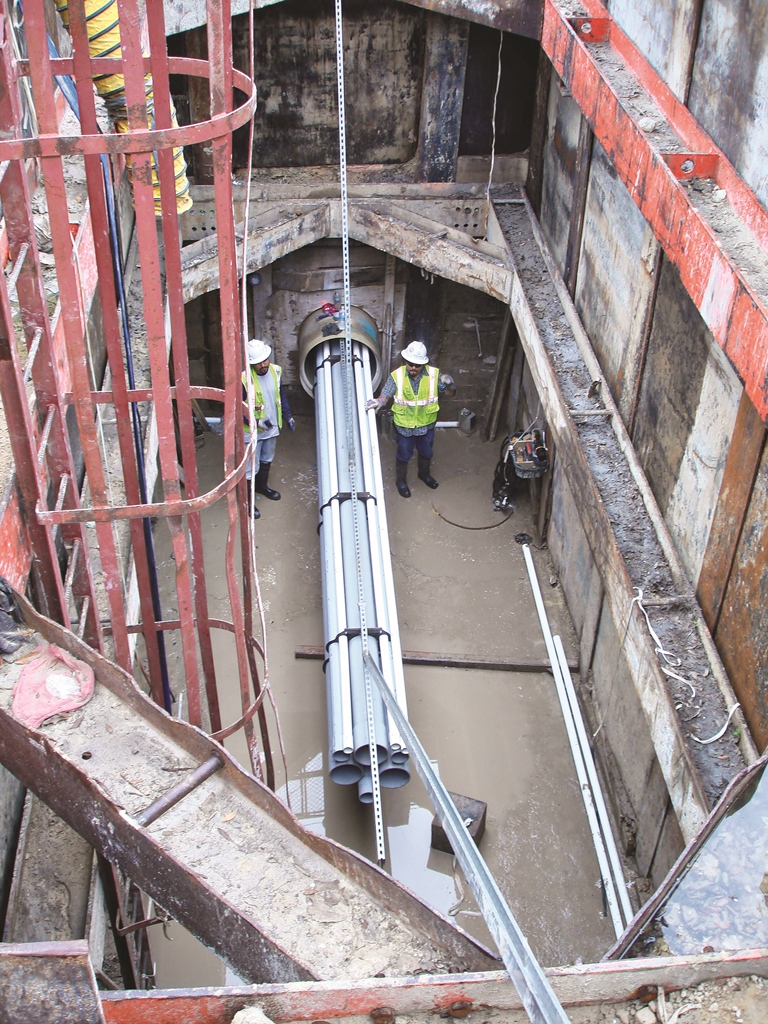
HOBAS Casing Pipes for Electric Transmission Project
Within the upgrade of an electric transmission circuit in Texas’ largest city, more than 2 km HOBAS CC-GRP Pipes were installed by jacking as casing for a transmission line.
With a population of 2.3 million, Houston is the fourth most populous city in the U.S. and the largest in Texas. Downtown Houston, the city’s central business district, hosts the headquarters of many prominent companies. The energy supply of Houston is managed by CenterPoint Energy. With a total of around 6000 km of transmission lines, 75,640 km of distribution lines and 232 substations, the company transmits and distributes electricity not only to Houston but to more than 2.1 million customers in a 13,000 km² area.
One of the underground transmission circuits serving downtown Houston is the 3.7 km 138 kV Garrott to Midtown to Polk circuit. Its rating for continuous operation is 247 Mega Volt Amperes (MVA). CenterPoint Energy recommended upgrading the underground circuit by installing a new cable parallel with the existing one to increase the capacity of the circuit to a continuous rating of approximately 498 MVA.
The existing 138 kV transmission line is located in an urban environment so installation of the new parallel line left no option other than trenchless methods. The local construction company Boyer, Inc. decided to build the casing for the new line out of centrifugally cast, glass fiber reinforced plastic. HOBAS Products were chosen for many reasons of which both their capability to be jacked over long distances and their non-conductive properties stood out: “The thermosetting resins used in the manufacturing of HOBAS Pipes retain their properties much better than thermoplastics when exposed to elevated temperatures,” explains Rene Garcia, engineering supervisor at HOBAS Pipe USA.
HOBAS Pipe USA supplied 2,134 m of CC-GRP Jacking Pipe De 752 for an allowable thrust force of 2,255 kN as casing for the conduit. Before construction began, Boyer performed a trial installation to ensure that the line would grout correctly. “Grouting on this project was important; you need complete coverage around the conduit because of the heat that is generated when the line is energized,” explained Barry Buse, project manager, Boyer, Inc.
The installation depth ranged from 6 to 9 meters. A Guided Boring Machine was built especially for this project with an electric motor, in order to comply to the urban environment’s noise pollution codes – customary tunneling machines with diesel motors would have been too loud for this purpose. The HOBAS Casing Pipes were jacked in runs of 120 to 150 m sections between pits. “We had high confidence in the quality of the HOBAS Casing, despite it having to endure some pretty high thrust forces,” stated Erich Schoennagel of CenterPoint Energy.
Once the casing pipe was in place a rail system was mounted along the inside top of the pipe. Boyer then installed a bundle of three 20 cm and three 10 cm PVC pipes in a spacer designed to support the weight of the product along with its accompanying grout and vent tubes. Particular attention was paid to the grouting process, to ensure maximum grouting of the annular space inside the carrier pipe.
The circuit was energized to the new capacity rating in late April 2012 and is performing very well since then.
More information about this application
PROJECT DETAILS
| Project ID: [7316] | |
| Country: | United States of America |
| City: | Houston |
| Year: | 2012 |
| Application: | Other Pipelines |
| Installation: | Microtunneling |
| Technology: | Hobas |
| Total Length: | 2134 m |
| Nominal Diameter DN: | 750 mm |
| Nominal Pressure PN: | 1 bar |
| Nominal Stiffness SN: | 160000 N/m2 |
